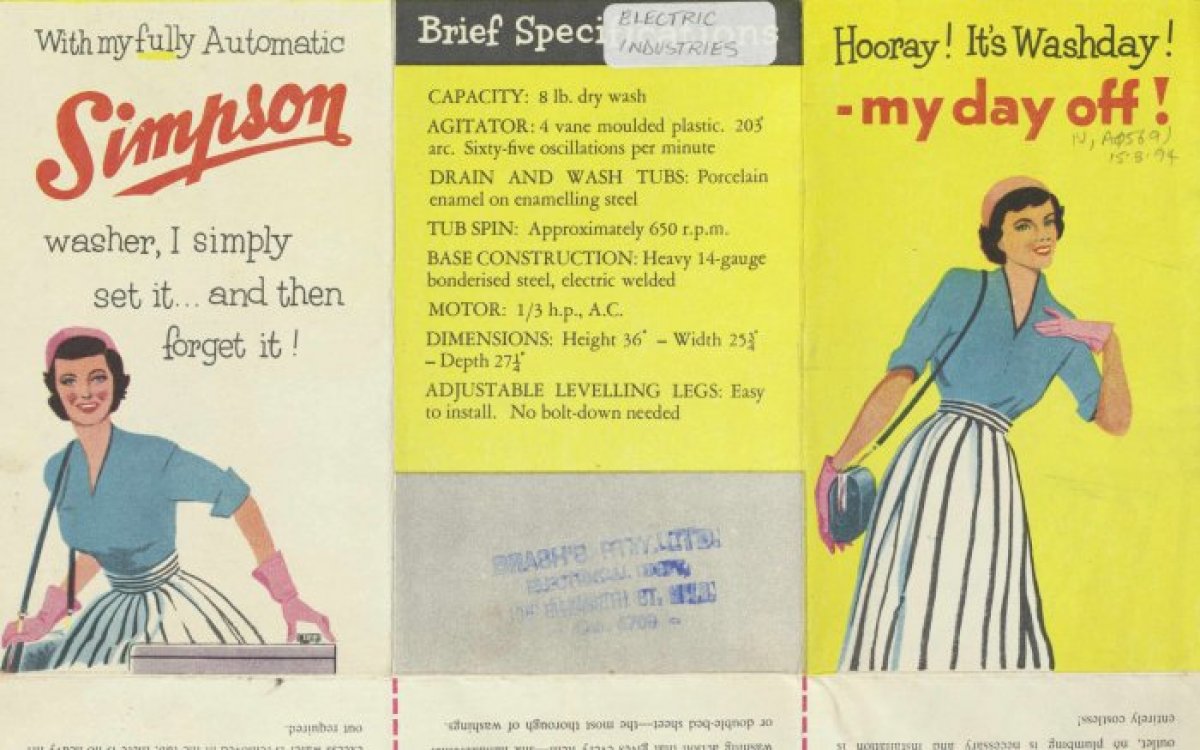This resource has been generously supported by Optus. Through the Digital Thumbprint program and Kids Helpline @ School, Optus supports digital knowledge and the positive use of technology.

Simpson (Firm) (issuing body.) (1950). Hooray! It's washday! - my day off!. [Australia] Simpson

Simpson (Firm) (issuing body.) (1950). Hooray! It's washday! - my day off!. [Australia] Simpson
After the Second World War, Australia embarked on a program of national reconstruction that included migration and major infrastrucuture projects. Suburbs grew, and the 'quarter acre block' became an important element of the so-called Australian dream. Between the end of the war and the 1960s around 70% of Australians would come to own their own homes. With these new homes came a need to fill them. Advertisers honed in on the new suburban dream and the aspirations of Australians. A particularly strong example of this is the advertising for advancements in home appliances.
Life-changing electrical appliances
Appliances were advertised as timesavers, allowing the previously dreaded washing day to become one of freedom. This foldout brochure is titled ‘Hooray! It’s Washday!—my day off!’
After the Second World War, Australia embarked on a program of national reconstruction that included migration and major infrastrucuture projects. Suburbs grew, and the 'quarter acre block' became an important element of the so-called Australian dream. Between the end of the war and the 1960s around 70% of Australians would come to own their own homes. With these new homes came a need to fill them. Advertisers honed in on the new suburban dream and the aspirations of Australians. A particularly strong example of this is the advertising for advancements in home appliances.
Life-changing electrical appliances
Appliances were advertised as timesavers, allowing the previously dreaded washing day to become one of freedom. This foldout brochure is titled ‘Hooray! It’s Washday!—my day off!’
The postwar era saw advertising reflect notions of the ideal Australian home, of masculinity and feminine beauty and of health.
- Have students brainstorm new forms of technology that affected people’s lives in these areas during the postwar era.
- Explore with students the level of influence that the consumer culture of the United States had over Australia in the postwar era. To what extent were developments in America and Australia similar and different?
- Have students use the Internet to investigate the economic circumstances of the postwar era.
- What financial situation was Australia in after the Second World War?
- How did this situation compare with other countries?
- What changes to work roles did the end of the war bring?
- What was the most common type of housing built after the war? Where were these houses built?
- Have students prepare to discuss how these factors influenced the consumer landscape, particularly in relation to home appliances, clothing, and health and beauty products.
Advertising in ‘The Weekly’

(1963, August 21). The Australian Women's Weekly (1933 - 1982), p. 6. http://nla.gov.au/nla.news-page4976234

(1957, December 18). The Australian Women's Weekly (1933 - 1982), p. 44. http://nla.gov.au/nla.news-page4826810
The Australian Women’s Weekly
During the 1960s, The Australian Women’s Weekly was read in one in four Australian homes. It had the highest circulation per head of population of any women’s magazine in the world. Advertisers realised that many women controlled the household budget and, as a result, targeted women in their campaigns.
The Australian Women’s Weekly
During the 1960s, The Australian Women’s Weekly was read in one in four Australian homes. It had the highest circulation per head of population of any women’s magazine in the world. Advertisers realised that many women controlled the household budget and, as a result, targeted women in their campaigns.
The Australian Women’s Weekly was a key advertiser in the 1950s and 1960s and produced advertisements of stunning impact and colour. They used rotogravure printing from 1936—a high-speed rotary relief technique—and offered advertisers a booklet on how to prepare their ads. Including advertisements was extremely lucrative for The Weekly and dominated its pages. In 1957, its circulation was over 750,000 copies and, in this issue of 87 pages, for example, there are 24 full-page advertisements, two double-page advertisements and 75 part-page advertisements.
- Why do you think The Australian Women’s Weekly was such a popular publication for companies to advertise in?
- Ask the class to browse issues of The Australian Women’s Weekly from the 1950s and 1960s on Trove. Using the same categories as before (the ideal Australian home, masculinity, feminine beauty, and health), have the students find one advertisement from each category to answer this series of questions:
- What kind of mood does the ad create? How does it do this?
- What is it about? Does the ad tell a story?
- Is the product a major one-time purchase or a consumable item?
- What sort of people is the ad targeted at? Why is that sort of people targeted?
- Are there any political, economic, cultural, social or gender attitudes reflected in the ad? What are they?
- Is sustainability or energy efficiency emphasised in the advertising. Why? Why not?
- Is the brand or product still around today?
- Have students give a short oral presentation on one of their ads as a stimulus for classroom discussion.



